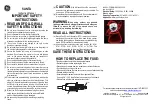
MTi and MTx User Manual and Tech. Doc., © 2005, Xsens Technologies B.V.
MT0100P.E
19
0.7mV or 360º / 4096 = 0.09º. In practice the accuracy is mainly defined by the signal noise
and the relative accuracy of the DAC (besides the accuracy of the orientation calculation
itself).
The relative accuracy is the deviation between a perfect straight line and the DAC transfer
function. Typical deviations are +/-2mV, maximum deviation specified for the DAC is +/-
11mV. The calibration certificate specifies for each channel the RMS value of the deviation.
An example of the relative accuracy is plotted in the following leftmost figure.
An example of the signal noise is shown in the figure on the right. The noise highly depends
on type of measurement and the use of antialiasing filters. See next section for additional
information.
2.8.3 Accurate measurement of analog outputs
In general when taking measurements at a specific sample frequency it is important to ensure
that the signal does not have frequency components that are higher than the sample frequency.
If these frequency components exist the sampled data will also contain these unwanted
components, i.e. aliasing. Therefore the use of a proper defined low-pass or antialiasing filter
is important as it will remove these unwanted frequency components. This filter should be
located as close as possible to the measuring point (e.g. at operational amplifier). To minimize
further noise contributions it is also important to use proper shielding and/or short cables.
The antialiasing filter used for the calibration is a one-pole lowpass filter for each channel.
This is a traditional RC filter, see next figure.
For highest accuracy it is recommended to make non-referenced single-ended measurement
instead of a ground referenced measurement. For example, if an instrumentation amplifier is
Analog line 1
Analog line 2
Analog line 3
Ground
From sensor
R
R
R
C
C
C
R = 8.2 kOhm
C = 100nF
Fc = 1 / (2
π
RC)
≈
194 Hz
To measuring
device















































